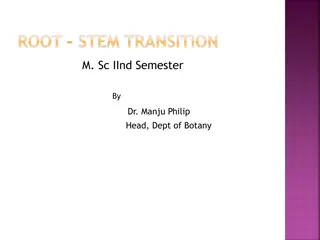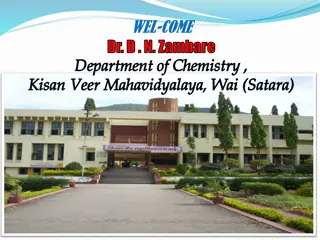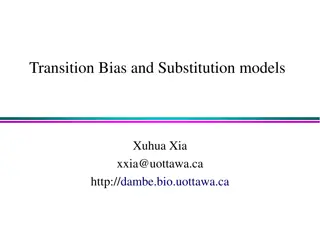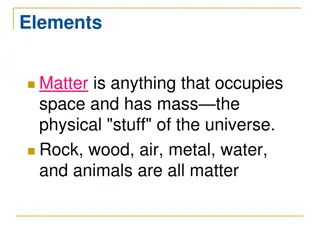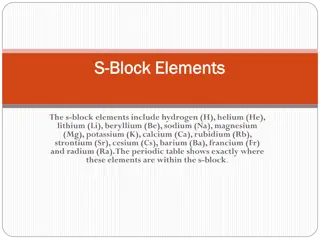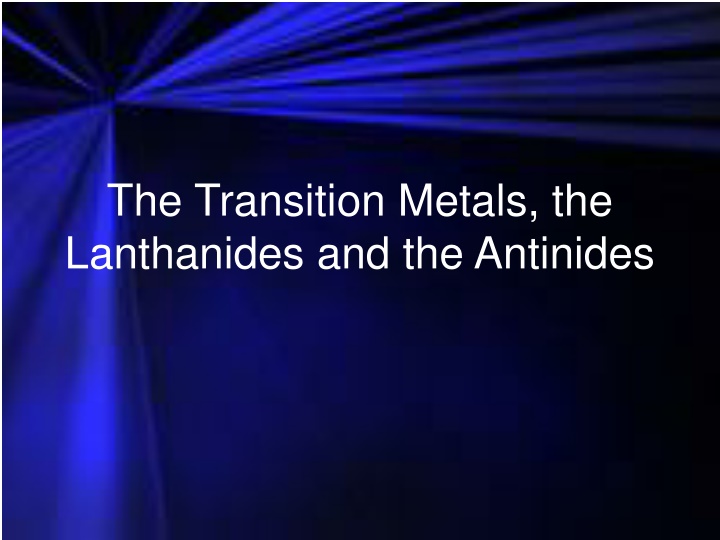
Transition Metals and Their Properties
Explore the unique characteristics and uses of transition metals such as the Iron Triad, Lanthanides, and Antinides. Learn about their high melting points, magnetic properties, and various applications in industrial and everyday settings.
Download Presentation

Please find below an Image/Link to download the presentation.
The content on the website is provided AS IS for your information and personal use only. It may not be sold, licensed, or shared on other websites without obtaining consent from the author. If you encounter any issues during the download, it is possible that the publisher has removed the file from their server.
You are allowed to download the files provided on this website for personal or commercial use, subject to the condition that they are used lawfully. All files are the property of their respective owners.
The content on the website is provided AS IS for your information and personal use only. It may not be sold, licensed, or shared on other websites without obtaining consent from the author.
E N D
Presentation Transcript
The Transition Metals, the Lanthanides and the Antinides
Transition Elements 3 The Metals in the Middle Groups 3-12 are called the transition elements. All of them are metals. Across any period from Group 3 through 12, the properties of the elements change less noticeably than they do across a period of representative elements. Most transition elements are found combined with other elements in ores.
Transition Elements 3 The Iron Triad Three elements in period 4 iron, cobalt, and nickel have such similar properties that they are known as the iron triad. These elements, among others, have magnetic properties.
Transition Elements 3 The Iron Triad Industrial magnets are made from an alloy of nickel, cobalt, and aluminum. Nickel is used in batteries along with cadmium. Iron is a necessary part of hemoglobin, the substance that transports oxygen in the blood. Iron also is mixed with other metals and with carbon to create a variety of steels with different properties.
Transition Elements 3 Uses of Transition Elements Most transition metals have higher melting points than the representative elements. The filaments of lightbulbs are made of tungsten, element 74.
Transition Elements 3 Uses of Transition Elements Tungsten has the highest melting point of any metal (3,410 C) and will not melt when a current passes through it.
Transition Elements 3 Uses of Transition Elements Mercury, which has the lowest melting point of any metal ( 39 C), is used in thermometers and in barometers. Mercury is the only metal that is a liquid at room temperatures. Like many of the heavy metals, mercury is poisonous to living beings.
Transition Elements 3 Uses of Transition Elements Chromium s name comes from the Greek word for color, chrome. Many other transition elements combine to form substances with brilliant colors.
Transition Elements 3 Uses of Transition Elements Ruthenium, rhodium, palladium, osmium, iridium, and platinum are sometimes called the platinum group because they have similar properties. They do not combine as easily with other elements. As a result, they can be used as catalysts.
Transition Elements 3 Uses of Transition Elements A catalyst is a substance that can make something happen faster but is not changed itself. Other transition elements, such as nickel, zinc, and cobalt, can be used as catalysts.
Transition Elements 3 Inner Transition Elements There are two series of inner transition elements. The first series, from cerium to lutetium, is called the lanthanides. The second series of elements, from thorium to lawrencium, is called the actinides.
Transition Elements 3 The Lanthanides The lanthanides are soft metals that can be cut with a knife. The elements are so similar that they are hard to separate when they occur in the same ore, which they often do. Despite the name rare earth, the lanthanides are not as rare as originally thought. Cerium makes up 50 percent of an alloy called misch (MIHSH) metal. Flints in lighters are made from misch metal.
Transition Elements 3 The Actinides All the actinides are radioactive. The nuclei of atoms of radioactive elements are unstable and decay to form other elements. Thorium, protactinium, and uranium are the only actinides that now are found naturally on Earth. Uranium is found in Earth s crust because its half-life is long 4.5 billion years.
Transition Elements 3 The Actinides All other actinides are synthetic elements. Synthetic elements are made in laboratories and nuclear reactors. Plutonium is used as a fuel in nuclear power plants. Americium is used in some home smoke detectors. Californium-252 is used to kill cancer cells.
Transition Elements 3 Dentistry and Dental Materials Dentists have been using amalgam for over 150 years to fill cavities in decayed teeth. Amalgam, a mixture of silver, copper, tin, and mercury, is the familiar silver filling.
Transition Elements 3 Dentistry and Dental Materials Because amalgam contains mercury, some people are concerned that the use of this particular type of filling may unnecessarily expose a person to mercury vapor.
Transition Elements 3 Dentistry and Dental Materials Today dentists have alternatives to amalgam. New composites, resins, and porcelains are being used to repair decayed, broken, or missing teeth.
Section Check 3 Question 1 Which three elements are known as the iron triad ? Answer The iron triad consists of iron, cobalt, and nickel. They are called this because of their similar properties.
Section Check 3 Question 2 Which group consists of ruthenium, rhodium, palladium, osmium, iridium, and platinum? Answer The answer is the platinum group. These elements all have similar properties, which is why they are grouped together.
Section Check 3 Question 3 What is most notable about the nuclei of the actinides? Answer The nuclei of actinides are unstable. All the actinides are radioactive, which means they decay to form other elements.
This powerpoint was kindly donated to www.worldofteaching.com http://www.worldofteaching.com is home to over a thousand powerpoints submitted by teachers. This is a completely free site and requires no registration. Please visit and I hope it will help in your teaching.







